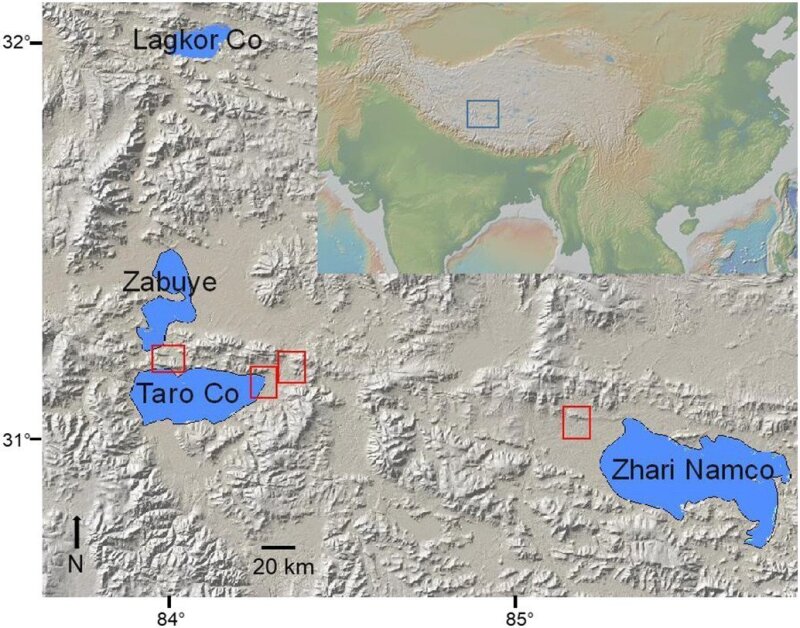Tibetan Plateau: Formation - Climate - Ecosystems (TiP)
MICROFOSSILS AS INDICATORS OF AQUATIC ECOSYSTEM EVOLUTION AND MONSOON DYNAMICS
part of the joint research "Lake System Response to Late Quaternary Monsoon Dynamics on the Tibetan Plateau" funded by DFG as part of the SPP 1372 "Tibetan Plateau: Formation - Climate - Ecosystems (TiP)"
06/2008-05/2014
Antje Schwalb (TU Braunschweig), Peter Frenzel (FSU Jena), Steffen Mischke (FU Berlin)
A coupled actualistic-ecological, taxonomic and molecular genetic analysis of Recent ostracode species from the Tibetan Plateau (TP) is performed, to use species assemblages and geochemical signatures of calcitic shells to detect lake system change in response to anthropogenic impact and monsoon dynamics at (a) annual to decadal resolution for the past approx. 1000 years from four lakes and at (b) decadal to centennial resolution from two lakes in order to detect long-term environmental changes and short-term events of the late Pleistocene and Holocene. Lake sites are strategically selected on the southern and northern TP in order to reflect distinct monsoonal airmass impact. The paleoenviron-mental interpretation of fossil ostracode assemblages will be based on ecological tolerances, pre-ferences and transfer functions. Our multiproxy appoach aims at the reconstruction of, for example, precipitation vs. evaporation ratios, lake level changes and water supply to the lake such as meltwater runoff that is controlled by monsoon dynamics and temperature. Distribution, species composition and intraspecific variability of Recent ostracode assemblages provide information on aquatic biodiversity and ecology. The coupling of modern taxonomic procedures, autecology, genetic techniques and the fossil record has the potential to date and find causes for speciation events. Overall, this study offers an avenue to better understand the evolution of biodiversity in aquatic ecosystems in the context of climate and geodynamic history of the TP.
Location of the Tibetan Plateau in China and position of the four studied sites: three of the Taro Co lake system (Taro Co, Zabuye Salt Lake and Lagkor Co) and Zhari Namco
Image: Alivernini et al., 2018Publications
Frenzel, P., Wrozyna, C., Xie Manping, Zhu Liping & Schwalb, A., (2010): Palaeo-water depth estimation for a 600-year record from Nam Co (Tibet) using an ostracod-based transfer function. - Quaternary International, 218: 157-165.
Schütt, B., Berking, J., Frechen, M., Frenzel, P., Schwalb, A. & Wrozyna, C. (2010): Late Quaternary transition from lacustrine to a fluvio-lacustrine environment in the north-western Nam Co, Tibetan Plateau, China. - Quaternary International, 218: 104-117.
Wrozyna, C., Frenzel, P., Daut, G., Mäusbacher, R., Zhu Liping & Schwalb, A. (2012): 16. Holocene lake level changes of Lake Nam Co, Tibetan Plateau, deduced from ostracode assemblage and δ18O and δ13C signatures of their valves. - [In:] Horne, D.J., Holmes, J.A., Rodriguez-Lazaro, J. & Viehberg, F. (eds.): Ostracoda as Proxies for Quaternary Climate Change (Developments in Quaternary Science, 17): 281-295; Elsevier, Amsterdam etc.
Wrozyna, C., Frenzel, P., Steeb, P., Zhu Liping, Mackensen, A. & Schwalb, A. (2010): Stable isotope and ostracode species assemblage evidence for lake level changes of Nam Co, southern Tibet, during the past 600 years. - Quaternary International, 212: 2-13.
